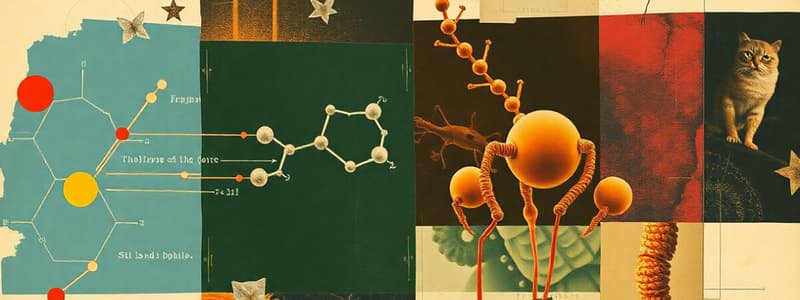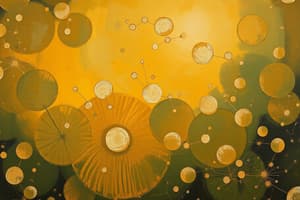Podcast
Questions and Answers
Which of the following is a characteristic of amino acids?
Which of the following is a characteristic of amino acids?
- They are inorganic bases containing a hydroxyl group.
- They are lipids containing a carboxyl group.
- They are complex carbohydrates containing a phosphate group.
- They are organic acids containing an amino group. (correct)
All amino acids found in proteins are D-amino acids.
All amino acids found in proteins are D-amino acids.
False (B)
What type of bond joins amino acids together to form proteins?
What type of bond joins amino acids together to form proteins?
peptide bond
Amino acids that contain equal numbers of positive and negative charges are known as ________.
Amino acids that contain equal numbers of positive and negative charges are known as ________.
Match the following amino acid groupings with their characteristic side chains:
Match the following amino acid groupings with their characteristic side chains:
Which of the following is the approximate mass of Glycine?
Which of the following is the approximate mass of Glycine?
Amino acids cannot arrive on earth through asteroid impacts.
Amino acids cannot arrive on earth through asteroid impacts.
What type of cellular functions do L-α-amino participate in?
What type of cellular functions do L-α-amino participate in?
Amino acids are the monomeric units of ________.
Amino acids are the monomeric units of ________.
Match the amino acid with its one-letter code:
Match the amino acid with its one-letter code:
Which amino acid has the one-letter code 'W'?
Which amino acid has the one-letter code 'W'?
All peptides are therapeutic and never toxic.
All peptides are therapeutic and never toxic.
Name the scientists who proposed that organic compounds could be made by passing an electrical current through the mixture of gases.
Name the scientists who proposed that organic compounds could be made by passing an electrical current through the mixture of gases.
Amino acids contain a(n) ________ group, a carboxyl group, and a side chain (R group) attached to a central carbon atom.
Amino acids contain a(n) ________ group, a carboxyl group, and a side chain (R group) attached to a central carbon atom.
Match the amino acid with its corresponding residue mass:
Match the amino acid with its corresponding residue mass:
In what system do small peptides act as hormones?
In what system do small peptides act as hormones?
Amino acids can only exist in the trans configuration around the peptide bond.
Amino acids can only exist in the trans configuration around the peptide bond.
What is the term for the ionized form of an amino acid with both a positive and negative charge?
What is the term for the ionized form of an amino acid with both a positive and negative charge?
The Miller-Urey experiment simulated lightning through gases to produce organic ________.
The Miller-Urey experiment simulated lightning through gases to produce organic ________.
Match each description with the correct type of amino acid side chain:
Match each description with the correct type of amino acid side chain:
Which of the following groupings does Cysteine belong to?
Which of the following groupings does Cysteine belong to?
The only function of amino acids is to serve as building blocks for proteins.
The only function of amino acids is to serve as building blocks for proteins.
What two functional groups must an amino acid contain?
What two functional groups must an amino acid contain?
The formation of a peptide bond involves the elimination of a molecule of ________.
The formation of a peptide bond involves the elimination of a molecule of ________.
Match each amino acid with its classification:
Match each amino acid with its classification:
Flashcards
Amino Acids
Amino Acids
Organic acids containing an amino group; the building blocks of proteins.
Amino Acids as Building Blocks
Amino Acids as Building Blocks
Monomeric units that form proteins, linked by peptide bonds.
Zwitterion
Zwitterion
A molecule with both positive and negative charges, resulting in a net neutral charge.
Peptide Bond
Peptide Bond
Signup and view all the flashcards
Peptide Bond Configurations
Peptide Bond Configurations
Signup and view all the flashcards
Amino Acid Groupings
Amino Acid Groupings
Signup and view all the flashcards
Aliphatic Amino Acids
Aliphatic Amino Acids
Signup and view all the flashcards
Hydroxyl/Sulfur-containing Amino Acids
Hydroxyl/Sulfur-containing Amino Acids
Signup and view all the flashcards
Cyclic Amino Acids
Cyclic Amino Acids
Signup and view all the flashcards
Aromatic Amino Acids
Aromatic Amino Acids
Signup and view all the flashcards
Basic Amino Acids
Basic Amino Acids
Signup and view all the flashcards
Acidic Amino Acids
Acidic Amino Acids
Signup and view all the flashcards
Acid Amides
Acid Amides
Signup and view all the flashcards
Dipolar Ion
Dipolar Ion
Signup and view all the flashcards
Amino Acid Properties
Amino Acid Properties
Signup and view all the flashcards
Stereoisomers
Stereoisomers
Signup and view all the flashcards
Isoelectric Point (pI)
Isoelectric Point (pI)
Signup and view all the flashcards
L-α-amino Acids
L-α-amino Acids
Signup and view all the flashcards
Twenty Common Amino Acids
Twenty Common Amino Acids
Signup and view all the flashcards
Water elimination in peptide bond formation
Water elimination in peptide bond formation
Signup and view all the flashcards
Peptide Bonds
Peptide Bonds
Signup and view all the flashcards
Study Notes
- Amino acids are covered
- Dr. Chandana Ambalanduwe is the author
Origin of Life
- Several theories suggest how life began on Earth.
- Two hypotheses pertain to organic molecules.
Miller-Urey Experiment
- Organic compounds could be produced by transmitting an electrical current through a closed system.
- The closed system contained a mixture of gases, simulating the atmosphere.
Meteorite Hypothesis
- Amino acids may have reached Earth via meteorite or asteroid impacts.
Biomedical Importance
- Amino acids serve as monomers of peptides and proteins.
- L-α-amino acids participate in cellular functions like nerve transmission, and biosynthesis of porphyrins, purines, pyrimidines, and urea.
- Small peptides function as hormones in the neuroendocrine system.
- Certain peptides exhibit therapeutic values.
- Some peptides are toxic.
Amino Acid Properties
- Properties of an amino acid vary based on the side chain.
- The side chains include nonpolar, uncharged polar, acidic, and basic.
- Amino acids are organic acids containing an amino group.
- α-amino acids exhibit stereoisomerism.
- Amino acids can exist as zwitterions, which contain equal numbers of positive and negative charges.
- Amino acids are the monomeric "building blocks" of proteins.
- Amino acids are joined covalently by peptide bonds.
- L-amino acids are the building blocks of proteins.
- There are twenty different L-amino acids found in proteins.
- The group of atoms surrounding the peptide bond can exist in either trans or cis configurations.
- The structure of the peptide bond is relevant.
Amino Acid Groupings
- Common groupings of amino acids include aliphatic, hydroxyl/sulfur, cyclic, aromatic, basic, acidic, and acid amides.
- A list details 20 amino acids used to make proteins, their one-letter code, and chemical properties.
Peptide Bond Formation
- A peptide bond is formed when the α-amino group of one amino acid residue forms a covalent bond with the α-carboxyl group of another amino acid residue.
- Water is eliminated in the process.
Additional Information
- Some common amino acids found in cells, such as ornithine and citrulline, are not used to make proteins.
- A rare amino acid, selenocysteine, is sometimes incorporated into proteins at UGA, which is normally a normal stop codon.
Tutorial Questions
- Discuss the importance of hydrogen bonds in the origin of life.
- Discuss the following topics in relation to amino acids: isoelectric pH (pI), pH values and the environment, solubility, and separation techniques.
Studying That Suits You
Use AI to generate personalized quizzes and flashcards to suit your learning preferences.




